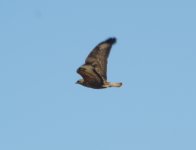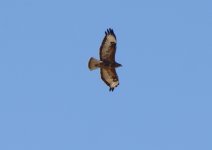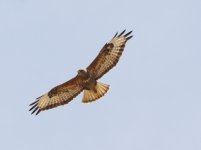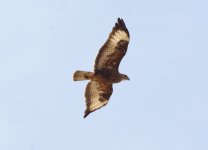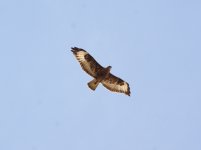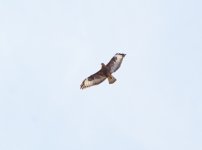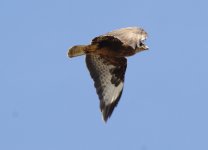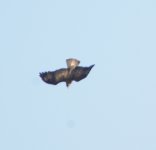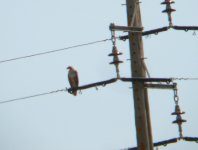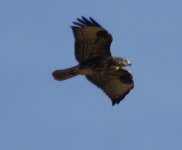-
Welcome to BirdForum, the internet's largest birding community with thousands of members from all over the world. The forums are dedicated to wild birds, birding, binoculars and equipment and all that goes with it.
Please register for an account to take part in the discussions in the forum, post your pictures in the gallery and more.
You are using an out of date browser. It may not display this or other websites correctly.
You should upgrade or use an alternative browser.
You should upgrade or use an alternative browser.
Buzzard Id Portugal (1 Viewer)
- Thread starter Rui_Caratão
- Start date
More options
Who Replied?Rui_Caratão
Well-known member
Not really, but what about steppe buzzards. I must say this is a breeding bird with one chick raised. Can Steppe Buzzards be safelly identified in the west if a rufous morph is also present in the nominate race?
Hi there,
Well, such features as the pale area on the underwing greater coverts would appear to exclude even cirtensis Long-legged Buzzard, which looks a lot more like Common Buzzard than nominate rufinus does, but, given information that Long-legged and Common have hybridised in Iberia, there would have to be a question asked as to whether or not a bird such as the subject bird is just due to variation within buteo, or if this bird has some Long-legged genes...?
I could easily buy this being a Common Buzzard, given the variability of the species, though I do acknowledge its similarity to some colour morphs of "Steppe Buzzard". It's not as rufous as a "fox red" morph vulpinus, mind.
Regards,
Harry
Well, such features as the pale area on the underwing greater coverts would appear to exclude even cirtensis Long-legged Buzzard, which looks a lot more like Common Buzzard than nominate rufinus does, but, given information that Long-legged and Common have hybridised in Iberia, there would have to be a question asked as to whether or not a bird such as the subject bird is just due to variation within buteo, or if this bird has some Long-legged genes...?
I could easily buy this being a Common Buzzard, given the variability of the species, though I do acknowledge its similarity to some colour morphs of "Steppe Buzzard". It's not as rufous as a "fox red" morph vulpinus, mind.
Regards,
Harry
Rui_Caratão
Well-known member
Harry Hussey said:Well, such features as the pale area on the underwing greater coverts would appear to exclude even cirtensis Long-legged Buzzard, which looks a lot more like Common Buzzard than nominate rufinus does
The same pale area on underwing GC is present on this bird at Vejer de la Frontera http://www.surfbirds.com/media/gallery_photos/20110223103710.jpg and another one in Cadiz http://www.surfbirds.com/media/gallery_photos/20051011121140.JPG
I havent seen those claimed hybrids from Spain or any photos of them, but 3 or 4 years had gone since the news were released!! I would expect more information regarding their ID.
Photos from a 2nd bird attached with strong features of adult cirtensis, so LLB genes are a really good question.
Attachments

Honnestly I have some major problems to follow here
Cirtensis and buteo are sometimes really diificult to separate given the enormous variability of buteo and now we are starting to see hybrids everywere!?
To me these birds are buteo and I would not even try to rule out hybrids as these birds must be unidentifiable in the field
Cirtensis and buteo are sometimes really diificult to separate given the enormous variability of buteo and now we are starting to see hybrids everywere!?
To me these birds are buteo and I would not even try to rule out hybrids as these birds must be unidentifiable in the field
Rui_Caratão
Well-known member
I must remenber that your everywhere, Tom !!! is only the South of Portugal, the South and center of Spain, and the South of Italy.
Simon Wates
Well-known member
Well, such features as the pale area on the underwing greater coverts would appear to exclude even cirtensis Long-legged Buzzard, Harry
Is this a sure-fire ID feature? I cannot see why it isn't a cirtensis Long-legged Buzzard. Some very recent survey work in the Portuguese Baixo Alentejo stepplands led by Luis Palma have "preliminarily" revealed close to 30 individuals of cirtensis inc. a few probable hybrids - and quote;. "breeding has apparently occurred". I think Andrea Corso has been helping out from a distance too. It seems that birds have either been overlooked or its a very recent phenomenon - or both! Seems like they are attracted to the large inland steppic areas in southern Iberia - but also seen at migration watchpoints in the south.
This species pair can be horrible to diagnose - and the few sightings I have had recently in the Baixo Alentejo haven't been close or complete enough - or have been of contentious individuals. I have seen some that I thought if I saw in Morocco I wouldn't think twice too! The eagle like structure of Long-legged is a great indicator when plumage cannot be seen properly - but in cirtensis this is more subtle and not always clear. Rui's first photo shows the structure of a Long-legged to me - unless I'm misjudging it ,)
Last edited:
Rui_Caratão
Well-known member
Hi Simon, this 2nd bird is a rufous morph by Andrea Corso kind comments, and raised also one chick, together with an odd "common" Buzzard.
I have been in the area not as long as Luis Palma but at least 15 different immature birds are present in the area by my counts, they have been overlooked as you know, but they are also very hard to see and hard to approach, the aerea has an allmost daily use by birdwatchers, and still, no reports on them....
That´s why I have asked for an opinion on Birdforum, not all birders, including the ones who have seen the bird on the field, agree on the ID. I´m somewhere in the middle, at least for the first bird, that shows an obvious patch on the breast like in nominate buteo or vulpinus.
Most of the birds present on the south of Portugal are mostly immatures on their 2 cy, with totally different jizz, and much more eagle like impression with longer tails, and with a slimmer wing effect, than these supposed adult breeders.
Although their breast and head pattern is highly variable, some like the bird on the other post seen in Spain, other with pale creamy heads with dark eye line, but all share, the long head impression with a small triangle on the nape and rectangular angle of the head on that area, dark trousers, orange tinge on belly, long tarsi etc etc.
I have been in the area not as long as Luis Palma but at least 15 different immature birds are present in the area by my counts, they have been overlooked as you know, but they are also very hard to see and hard to approach, the aerea has an allmost daily use by birdwatchers, and still, no reports on them....
Simon Wates said:Rui's first photo shows the structure of a Long-legged to me - unless I'm misjudging it ,)
That´s why I have asked for an opinion on Birdforum, not all birders, including the ones who have seen the bird on the field, agree on the ID. I´m somewhere in the middle, at least for the first bird, that shows an obvious patch on the breast like in nominate buteo or vulpinus.
Most of the birds present on the south of Portugal are mostly immatures on their 2 cy, with totally different jizz, and much more eagle like impression with longer tails, and with a slimmer wing effect, than these supposed adult breeders.
Although their breast and head pattern is highly variable, some like the bird on the other post seen in Spain, other with pale creamy heads with dark eye line, but all share, the long head impression with a small triangle on the nape and rectangular angle of the head on that area, dark trousers, orange tinge on belly, long tarsi etc etc.
Attachments
Last edited:
Rui_Caratão
Well-known member
Tconzemi said:Honnestly I have some major problems to follow here
Cirtensis and buteo are sometimes really diificult to separate given the enormous variability of buteo and now we are starting to see hybrids everywere!?
To me these birds are buteo and I would not even try to rule out hybrids as these birds must be unidentifiable in the field
I agree with you Tom, the enormous variability of buteo is major problem on cirtensis identification, but what about cirtensis variability? what do we now about that. But your objective opinion, as from others is most welcomed!!
Probably its not possible to separate some morphs in the field, some eaven suggest they are the same, like Valéry and others based on DNA, although, I can say based on my still very fresh experience with this birds, that behaviour is diferent at least in Baixo Alentejo.
Its like comparing ground squirrels with tree squirrels, cirtensis love to be on the ground, and no more than 1 and 1/2 mt above it 95% of the time, eaven when they have tree tops, telephone posts, et etc.
Feeding behaviour http://www.youtube.com/watch?v=dFnRN78Eduo
Bird number 3 is from a 2 cy bird, on a very rare moment a few meters above the ground, and bird number 4 is from a recently fledged chick, I only have seen the mother wich seemed very common Buzzard to me. However there is something on the chick/juvenile jizz, mainly head and neck, that I am not able to fit it in buteo, so I really would like an opinion from others!
Attachments

I agree with you Tom, the enormous variability of buteo is major problem on cirtensis identification, but what about cirtensis variability?
However there is something on the chick/juvenile jizz, mainly head and neck, that I am not able to fit it in buteo, so I really would like an opinion from others!
Hi Rui
the whole story is most interesting, let me just add a few comments:
imho it's simply impossible to judge jizz on single photographs, so your personal impression in the field is much more important than comments here on BF, this obviously including behavior
CB is most common BOP in Luxembourg but again they look simply different because of colder climate and less wear of plumage due to sun (especially this summer!)
It would be most interesting to compare populations in Southern Iberia and Northern Iberia and to look for several key features in both populations, surely more interesting than debating individuals.
A paper on variability of cirtensis is more than overdue, Andrea is talking about this for years...
and a last interesting fact on cirtensis "migration". In our wild bird rehabilitation center in Luxembourg we get over hundred Buzzards a year (more than 1000 animals a year) and the last 15 years or so we got 3 cirtensis! 1 baby bird brought from Algeria by an immigrant family returning from their summer visit to Algeria, two recently fledged birds found in Nature in very, very bad feather conditions and IDed only after their first moult. So 3 birds brought from Northern Africa in ten years to such a small spot as Luxembourg and surroundings. There must be hundreds of smuggled birds to Iberia.
Last edited:
Rui_Caratão
Well-known member
tconzemi said:It would be most interesting to compare populations in Southern Iberia and Northern Iberia and to look for several key features in both populations, surely more interesting than debating individuals.
Agreed
https://plus.google.com/photos/1110...062329240640229474/albums/5453437645654462913
https://plus.google.com/photos/1158...832388218710532919/albums/5478288215583517121
Users who are viewing this thread
Total: 2 (members: 0, guests: 2)




